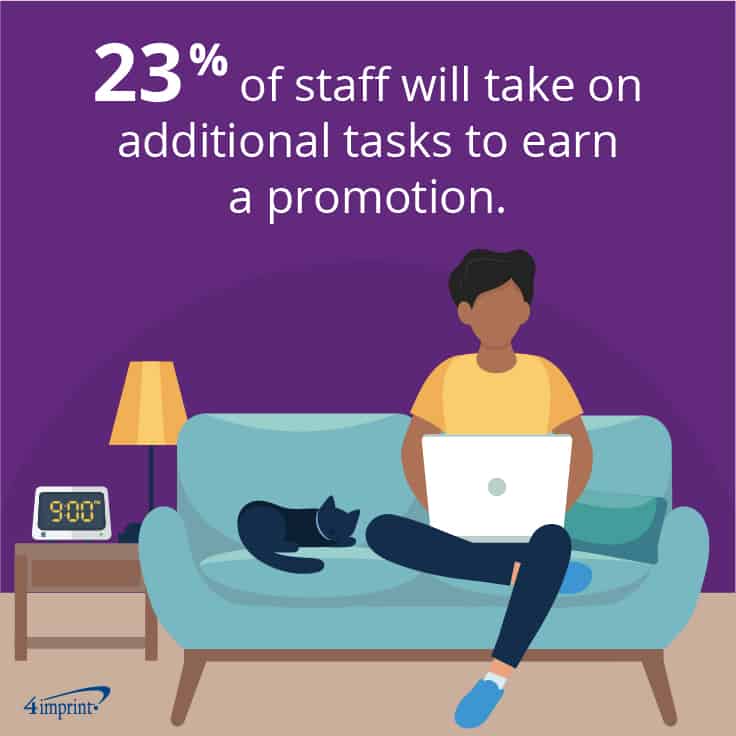When your organization needs new leaders, your best choice is likely nearby. Current employees who have proven leadership potential are often tapped as managers, and rightly so. By taking a team player and helping them transition from peer to team leader, you take the knowledge and skills your top employees already have and use that to build their potential—and your business.
This edition of our Blue Papers® discusses the many advantages of promoting from within. And we’ll show you how to make that transition simple and smooth.
Business benefits of promoting team members
When you help an employee transition from peer to team leader, you’re also helping your organization. Promoting staff to leadership roles comes with a lot of benefits:
- Smoother transitions: Internal candidates already know your business niche, your company culture, and many of the employees they’ll be working with—all of which saves you time in onboarding a new associate.
- Cost savings: Thanks to that smooth transition, and the fact that new hires often receive a higher salary, internal candidates reduce recruitment costs by 20%.
- Boost employee satisfaction: 94% of employees say they would stay at a company that invests in their career, which means promotions will help you keep your best staff members.
Janicki Industries in Sedro-Woolley, Washington, knows the value of promoting from within. A niche business in a close-knit community, Janicki Industries has benefited from tapping its team’s experience. By allowing employees to move into leadership positions, the company is able to take advantage of the knowledge and training its employees have already received.
“The nature of our work is pretty unique,” said Robert Baize, Operations Support. “We’re a composite tooling manufacturer for aerospace, defense and a variety of other industries, and we’re in a little town in Washington. There are not a lot of people who know what we do and how we do it.”

Give your new leader a boost
Once you’ve established that you want to promote from within, supporting new managers will be critical to their success. After all, studies show that making a work transition is considered life’s most difficult challenge.
To help your new leaders thrive:
Allow time to transition
Moving from one role to another doesn’t need to happen instantly. Having new leaders go through a period of transition, training and increased responsibility gives them time to fully understand the role. And it gives the rest of the team time to adapt to their former teammate moving into a position of authority.
Create a path with training classes, projects and other steppingstones to encourage staff to level up. Establishing a leadership succession plan—based on hard work and hard data—also makes it easier for the rest of the team to understand how a coworker moved up to the next level. What’s more, it often results in employees choosing to take on more responsibility: It’s estimated that 23% of staff members will take on additional tasks to earn a promotion.

Janicki Industries allows new leaders to progress one step at a time. “If we see someone show leadership skills, we’re always happy to let them try running a project,” Baize said. “That’s sort of like a test drive. The people who are successful at that, we’ll then move into a formal lead position.”
Leads can then continue to climb the ladder. “People who have been leads, who have been successful for a while, they’re the people who are going to be successful as a cell manager,” Baize said.
Offer training and mentorship opportunities

Eighty-three percent of companies think it’s important to develop leaders, but only 7% of them have implemented leadership development at every level. Provide training or pair a new manager with a mentor or mentors to help them maximize their potential:
- Share expertise: Suggest leadership books or pair the newly promoted associate with a mentor who can answer questions and provide advice.
- Give frequent feedback: Share what leaders are doing well—and what they need to correct—so they can fine-tune their approach. Janicki Industries also celebrates managers with team manager gifts, like polo shirts, which serve as a reward for hard work and a way to represent the team.
- Offer training: Much like a new employee being onboarded, help new managers get up to speed by setting up training sessions for their first few days.
One customer we spoke with literally “shows” people how to be leaders. At every training session, the group hands out a mirror as a team manager gift to remind trainees of what other people are seeing.
This mirror helps them to see that if they want to create a certain behavior or result in their team, they first have to be able to make that change in themselves—because the only person they have control over is the person in the mirror.
Help them build an internal and external network
Managers often have to work with other leaders and other companies. Building a strong internal and external network teaches them how to communicate with people outside their team. Help your new managers improve their networking skills by:
- Encouraging them to go out of their way during internal gatherings and meetings to meet people outside their usual circles
- Giving them a chance to interact with peers through industry or leadership associations
Get staff members on board
Of course, new managers aren’t the only ones going through a transition. Watching a colleague go from being a peer to a manager can strain the team. Former peers who are passed over for a promotion or suddenly discover they’re a direct report to someone they consider a friend may struggle with this new dynamic. Thankfully, there are ways to help team members handle the change:
Help staff see the advantages
Help the rest of the team focus on the advantages that come from having their former colleague in a leadership role:
- Valuable investment: New managers or supervisors already have a vested interest in the company and their teammates.
- Built-in understanding: Unlike outside managers who have to learn strengths, weaknesses and needs of their team, new leaders from within the organization will already know the team well and may already have plans to strengthen it even more.
Talk it out
New leaders will frequently find that going from “friend” to “boss” changes their interactions with their former peers. Have them take steps to build trust with their team:
- Communicate: Talking with team members one-on-one can help them feel comfortable and voice ideas and concerns they might not otherwise share.
- Be open: Let team members know that their new boss will accept feedback and ideas to help the team succeed.
- Take time: Consider phasing in the new leader over 60 to 90 days. It can help calm fears and stress caused by too many adjustments happening at one time.
Making the move to management more manageable
Making a transition from peer to team leader has a lot of advantages—and many challenges as well. Helping your new leader move from team member to team manager will smooth the transition for everyone.

